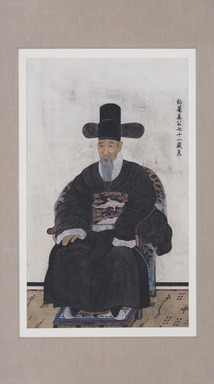
Medium: Ink and colors on paper
Geograhical Locations:
Dates:ca. 1900
Dimensions: 41 3/4 × 28 1/2 in. (106 × 72.4 cm)
Collections:
Accession Number: 2021.18.15
Image: 2021.18.15_PS11.jpg,
Catalogue Description: Portrait of a man in the traditional costume of a Joseon-dynasty courtier, seated in a chair. The subject has a long gray beard and narrow face. He wears the tall silk cap with lacquered horse-hair "wings" worn by courtiers when performing official duties. His robe is in dark green-ish black with a white under-robe visible at the collar and sleeve ends. In an interesting feature, he has one hand bared, resting on his knee to reveal long fingernails, while the other is concealed within his long sleeve. He wears a large rank badge of cranes and clouds, and a belt buckle of indeterminate material. His shoes are visible beneath the hem of his robe. He sits in a arch-backed arm chair that has been covered with a leopard skin; his feet rest on a low stool, onto which the skin drapes. The chair and stool are on a woven straw mat with small decorative accents woven in a darker color and a colorful border. Behind him is a blank background, and a one-line inscription on the viewer's right, identifying the sitter. This is a portrait of Kang Se-hwang (artistic name Pyo-am, 1713-1791), a noted painter and art critic, whose writings about art are a valuable resource for study of painting in 18th-century Korea. This portrait is a copy of a painting made during Kang's lifetime,dated to 1783, painted by Lee Myung-gi (born 1756), now in the National Museum of Korea (National Treasure number 590). The original is on silk and offers a far more detailed and sensitive likeness of the subject, with carefully rendered wrinkles and age spots and a visible pattern in the weave of the dark robe. It has a 5-line inscription. It has been suggested that some details of Kang's likeness were copied by Lee from a self-portrait made by Kang one year earlier. That painting is also in the National Museum of Korea, donated by the same party. This copy, on paper and smaller than the original, is not signed by the artist and is in a more cursory style, although faithful to the composition and general tenor of the original. Based on its style and pigments, it appears likely to have been made in the early 20th century. Such copies were made for dissemination to Confucian academies and other settings where the portraits of noted historical figures were installed as a source of inspiration and even as recipients of secular reverence, rather like ancestors. Indeed, the original portrait was donated to the National Museum by the "Jinju Kang Clan's Baekgak Gongsan Sect."